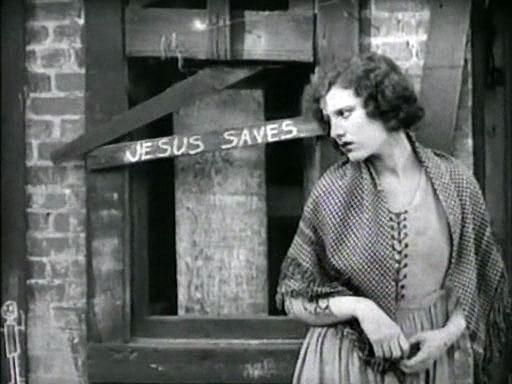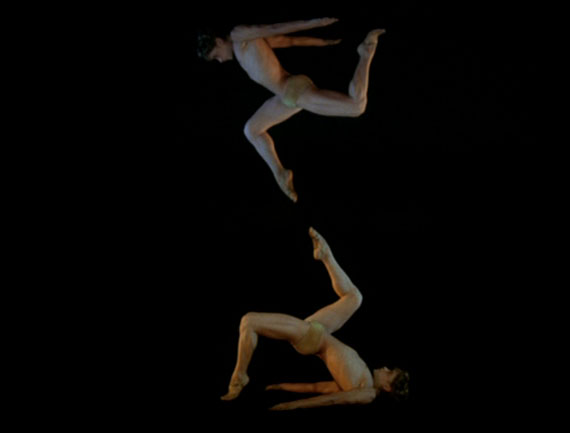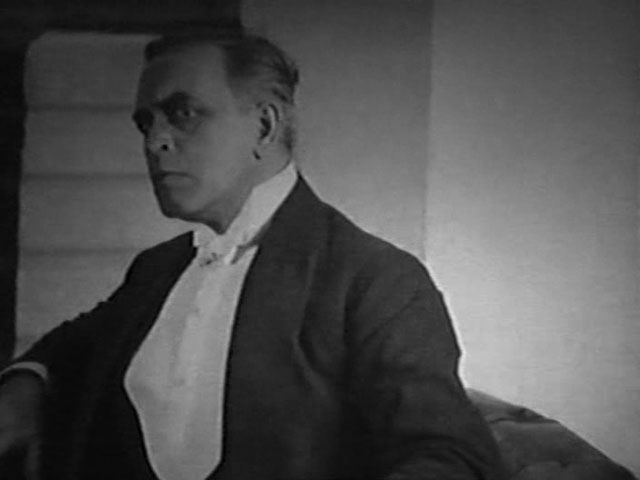The Feuillade movies I’ve watched just keep getting better – from Les Vampires to Judex to Fantomas – and I’d heard this might be a total masterpiece, but I was disappointed. Mildly, I mean – it’s a fun movie and all, but it doesn’t hold up as a long-form piece as well as the others. Strange to think his films are a hundred years old. Supposedly he was assisted on this by a young Julien Duvivier.
Can you tell these two men in suits apart?

As usual, I dig the opening credits, motion portraits of each major character. Jacques (serious explorer, close light brown hair, wearing a robe for some reason) returns from Indochina (Vietnam) with Tih Minh, “a young Anamite who had saved his life,” with whom he is chastely in love. Jacques is played by René Cresté – Judex himself. In fact half the cast had recently been in Judex and would appear in Barrabas the year after this. Jacques’ comic-relief servant Placide (a goofball with center-parted hair) is glad to be home and see his fiancee, the maid Rosette (dark-haired and suspicious-looking, but she turns out to be a sweetie). Jacques’ sister Jeanne sets out to “educate” Tih while Jacques and Placide (poor guy) go off to India. Two years later they return and prepare for a double wedding.
1910’s special effects:

Meanwhile, Paris is plagued by a string of robberies and kidnappings perpetrated by evil Dr. Gilson (I can’t describe him, since he’s always got some kind of fake facial hair), Kistna (introduced with a turban and beard) and Marquise Dolores (sultry with big hair). Others mention Kistna as the “Hindu servant” of Dolores, but in private he’s shown bossing her around. The big buzz is that Jacques is bringing home a book from India, The Nalodaya, with a hand-written section by someone called Ourvasi. “In addition to revealing the existence of fabulous treasures, this testament could be of considerable importance in the event of a European war.” The baddies get Tih Minh alone when she’s taking a boat ride, kidnap and brainwash her to collect the book for them. But: “Motivated by what he believes is a laudable zeal, Placide erases Ourvasi’s testament,” so they get a worthless book.
Dolores in disguise:

And it goes on and on and on like this. The criminals don’t commit any more major crimes to terrorize Paris, they only try to get this book (well, now it’s the photograph Jacques took of the inscription before Placide erased it) for the next five hours, trying again and again and again with minor variations. Kistna comes over, all neighborly, and asks to borrow the book and see the photos. Tih Minh is kidnapped at least two more times (oh, and it takes dapper, puffy-cheeked Dr. Davesne weeks to restore her memory after the brainwashing incident). Each group breaks into the other group’s house at least once. Twice the baddies get a spy into the heroes’ house and twice they try to poison our guys. People hide in trunks. Fake beards and mustaches of every sort are used then discarded. It’s a cool flick but I’m not seeing how it’s on the level of Fantomas or Judex.
Dolores (?) and Kistna:

My copy of the movie had no sound at all, so I used soundtracks from elsewhere:
– Mike Patton’s Mondo Cane (I am obsessed with this disc lately)
– The Paranoid Park soundtrack
– Zbigniew Preisner’s Double Life of Veronique soundtrack
– Mihaly Vig’s Bela Tarr soundtracks (love those Werckmeister Harmonies songs)
– Volume 3 of the Toru Takemitsu set:
(“music from the films of Nagisa Oshima and Susumu Hani”) – this was ideal.
– Hajime Kaburagi’s soundtrack for Tokyo Drifter didn’t work out, so on to Philip Glass and Kronos Quartet’s Dracula, which didn’t work either.
– Peer Raben’s Fassbinder soundtracks (volume 1 – only the non-vocal numbers)
– Then back to Mike Patton and Mihaly Vig

Not a lot of writing on this movie online besides this nice article by A. Cutler of Slant, so I’ve perhaps quoted too much of it:
The movie doesn’t have a plot so much as a list of incidents. I don’t feel like I’ve given much away, since the one-damn-thing-after-another structure keeps the viewer watching more for what happens moment to moment than for where the story’s going overall. As a consequence of its cliffhangers, and despite its length, Tih Minh zips. … Feuillade is able to depict such wild happenings onscreen because his foundations are so solid. I mean this not just from a storytelling perspective, but from a visual one. The director consistently relies on static medium-to-establishing shots, proscenium-like in their orientation, the camera viewing the characters from a slightly elevated angle, and the lighting’s generally unobtrusive. In other words, Feuillade gives us a relatively normal, stable-looking frame so that the odd happenings within it can seem all the more disruptive.
Feuillade is filming a rousing adventure story, but he’s also questioning the future of the world. It’s a world explicitly without central authority figures, in which the characters fight to assert their own moral order—as one of d’Athys’s companions conveniently says late in the film to justify hunting the thieves, “why inform the police? We are mixed up in the most remarkable adventure in the world, let’s go all the way with it ourselves.” … The film balances its societal poles so that Nature ultimately has to intervene. Toward the end of the film, as the felons flee into the mountains, Feuillade moves his camera several hundred feet back and we see them as specks in the landscape. Unlike Les Vampires, in which the black-clad Irma Vep appears and disappears at her liking, the antagonists here never seem more than human; once the boulders crash, they seem especially so. D’Athys, a bland hero, triumphs over his adversaries not through skill so much as through luck and fate. Rather than a screenplay deficiency, this seems the movie’s point.
Les Vampires came out the same year as The Birth of a Nation, but as Jonathan Rosenbaum writes, Griffith and Feuillade “seem to belong to different centuries. While Griffith’s work reeks of Victorian morality and nostalgia for the mid-19th century, Feuillade looks ahead to the global paranoia, conspiratorial intrigues, and SF technological fantasies of the current century, right up to today.” The most appropriate comparison for Tih Minh isn’t to another silent film, but to a recent hit like The Dark Knight. Both films are about shape-shifting, disguise-donning villains and the heroes who take the law into their own hands to stop them. Both films structure themselves as a series of setpieces alternating between each party’s capture and escape. Both films are allegories about the wars their countries were then fighting (Tih Minh‘s gang is a gaggle of foreigners; several Dark Knight characters call the Joker a terrorist). Yet Tih Minh trumps The Dark Knight stylistically, tonally, and thematically. … The Dark Knight insists that wire-tapping, torture, and government cover-ups are necessary in the name of freedom, accepting these precepts fatalistically; Tih Minh, by contrast, shows us a world worth saving. … One film exhausts, the other liberates; the comic book film thinks it’s addressing reality, but the human film knows it speaks the language of dreams.

Jacques in asylum:

Notes I took:
“She is like Lord Stone. She will not betray us.”
Kistna comes right over and borrows the book, so why the brainwashing?
“But Tih Minh, the beloved, had drunk the potion of forgetfulness and did not even know how to speak anymore.”
I think they are saying that Gilson and the Marquise are psychic
The comedian got pushed over a cliff into water while the marquise tried to rob the house, caught by Jacques and passed out.
25 kidnapped girls in the basement!!

They encounter a petrified dog, aww Kistna is experimenting on cute puppies.
Kidnappees spend their days having pajama fights
Servant caught in wolf trap, Jacques leaves him.
Plac as hero is upright, not goofy as I expected.
Haha, he lures Tih out of the house to the beach using a cat.
Just as Tih is returned home, obsessed with a cat, Rosette is delivering the photos to fake-beard Gilson. Plac and Ros beat the hell out of him. Time for him to face the fact that he is a very ineffectual villain.
Music for In the Realm of Passion fits so well, I’d forgotten it wasn’t part of the movie.
“Agents of Germany” want to steal the secret. Wow, WWI wasn’t over yet.
Baddies hid microphones in the garden. That’s hell of high technology they’ve got there.
Now Gilson and Dolores are trying to steal the document – all they ever do is try to steal the document and it’s getting a bit boring.

Marx killed a servant after breaking in, then shoots her dad. Marx is Gilson!
This is the kind of car chase that was possible in 1918: the bad guys are driving away at top speed, Jacques is able to catch up by running.
Rosette is an excellent shot
Oh it’s all in goofy fun that we drive away the false nuns who threatened our lives by spraying them with a garden hose as they scurry away. They’ll be back in 15 minutes threatening your lives again.
Jacques seems to be telling Tih that pretty girls should be home arranging flowers, not out avenging the death of their father.
Now it’s an evil cook working in the house with a messenger dog, both of whom “no one suspects.”
Why don’t they stop letting people into the house. No nuns, no new servants, not anybody. Stupid rich people with houses like hotels, servants galore and people always coming and going.
Holy crap, one of the bad spies just killed Dolores with a rock.
The heroes’ plan fails, because of course it does. Our heroes are so foolish that when the baddies are disarmed they use Rosette and Placide as human shields, and this works. They’re DISarmed. You can just run around Rosette and punch the bad guys in the face. But no, they all escape.
I prefer inspector Juve and his reporter sideick Fandor from the Fantomas series. Not only are they in higher-definition than the identical suit-wearing blobs of this movie, they’re much smarter.
Oh good Dolores isn’t dead.
They escape to the rooftops! Finally. It’s just not Feuillade without a chase on the rooftops.

The three baddies turn on each other.
One’s head is smashed with a rock.
Gilson is still alive.
Gilson throws kistna off a cable car.
Gilson is blown up by dynamite!
Kistna is found dead.
Dolores kills herself.
Wedding!

























































